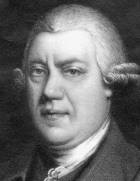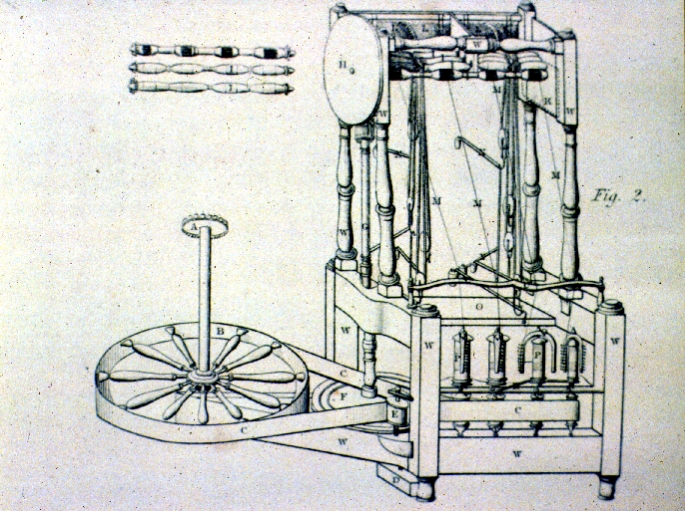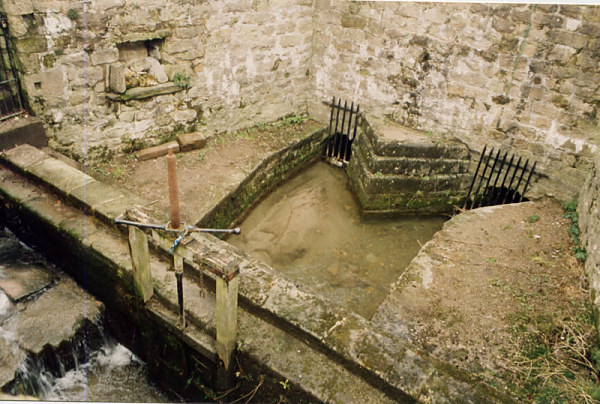
In 1946, after the end of the Second World War, a booklet was produced by the Sir Richard Arkwright & Co Ltd, Masson Mill, to mark the end of the war and the beginning of a new peacetime prosperity.
The following article "Cotton, Then and Now", tracing the history of cotton spinning and the part played by the company's founder, Sir Richard Arkwright, is taken from the booklet.COTTON, THEN AND NOW
There are few things which we are more inclined to take for granted than cotton, and yet few things have made a greater difference to ordinary, everyday life.
It was only just over two hundred and fifty years ago that we began to import cotton in any great quantity, and we did not use much ourselves until the middle of the 18th century. Even then the goods produced were of an inferior kind, because we did not know how to spin yarn strong enough to make the warp threads in the cloth, so we had to use linen for that purpose, and the result was an inferior mixture called fustian.
At first all the work was done at home. In many places in Derbyshire and the north of England merchants gave out the raw cotton to the workers, and the whole family, from grandparents to small children, combined in the various processes. The cleaning, carding and spinning was done by the women and children, while the men and older boys did the weaving, and it is easy to see that it took six or seven workers to make enough yarn to keep one weaver busy. It was all done by hand, and when the cloth was finished it was collected by the merchant, who paid for the work which had gone into making it.
By 1750 several attempts had been made to invent machinery to make the manufacture of cloth quicker and easier, but none had been successful. It was our own Richard Arkwright who was mainly responsible for the first great improvements and discoveries which were made.
Richard Arkwright was born in Preston in 1732, the thirteenth child of a poor man. This did not seem a very fortunate beginning, and for many years he had a hard struggle. He had very little schooling; indeed he gained most of his education late in life, for when he had become rich he still used to practise grammar and spelling, until, we are told, he wrote a very good business letter. He was always interested in mechanics, but when he was quite young he was apprenticed to a barber, and when he had finished his time he set up his own little shop in a cellar in Bolton.
Barber
Here he soon showed the enterprise which was to be the foundation of his fortune by putting out a sign "Come to the subterraneous barber; He shaves for a penny".
This was only half the price charged by his business rivals, and he was so successful that they soon had to bring down their charges to the same level. Nothing daunted, Richard then went one better with a new notice "A Clean Shave for a Halfpenny."
When he was about 35 he obtained the secret of a process for dyeing human hair, which was very valuable as wigs were then in fashion. All this time he had been making mechanical experiments. His wife had died and in 1761 he remarried. The second Mrs Arkwright did not approve of him wasting time with machinery when he should have been building up the barber's business, so one day, while he was out, she burned all his models. This seems to have been the reason why he left home and started to travel about the countryside buying hair, which he dyed and sold to wigmakers.
He had spent all his life among textile workers and knew a great deal about their trade and during his journeys he met still more of them. By this time he was working on the idea of a spinning machine which, by taking the cotton sliver over two sets of rollers, the second revolving faster than the first, would make a yarn much better than could be spun by hand. At last it was finished, but he was too poor to put his machine into production himself, so he had to find somebody who could give him the financial help he needed.
Meeting Strutt
After a number of setbacks he at length met Mr Jedediah Strutt of Nottingham, a hosiery manufacturer who had himself adapted the stocking-frame to make the famous "Derby rib." He was very impressed by Arkwright's invention and he and his partner, Mr Need, agreed to finance it, and the three men entered into partnership.
At last the invention was patented, a frame was made after Arkwright's model and production started in 1769, in Nottingham.
 ARKWRIGHT'S WATER-FRAME
ARKWRIGHT'S WATER-FRAME
At first the frame was driven by horse-power, but this proved too expensive, so the firm moved to Cromford in 1771. During his journeys round the countryside Arkwright must have seen what an excellent place this was for a mill, * with the river to drive the new machinery. A year or two later a larger mill of six storeys was built, and for this the water from local streams and from the Wirksworth mines was used, being carried over the road by a culvert to fall on to and turn the mill wheel. As this water was at a higher temperature than normal it never froze in winter, so that even in the coldest weather the mill was in no danger of having to stop work; it also prevented the adjoining canal from freezing over, so that in those days before the railways there was always easy transport available to and from the mill.
So Arkwright and his partners began to make the new yarn, which was much stronger and more uniform than was possible when spun by hand, and could be produced in much larger quantities. This made it cheaper than any other, but manufacturers of cloth were prejudiced against it and would not buy it. This meant that Arkwright had to dispose of it elsewhere, so his partners decided to weave it into calico in their new mill which they built at Belper. This was the first cloth ever to be made in England entirely out of cotton, for the new yarn was so strong that it could be used even for the warp as well as the weft. It was also very suitable for hosiery, and so was of great assistance in the stocking trade in Derbyshire and the Midlands.
Court Cases
By this time the other manufacturers realised that Arkwright's frame had come to stay. They were jealous of his success and combined against him, and, accusing him of having borrowed his ideas from other inventors, brought a case into court to have his patents set aside. After several years they succeeded in getting this done, but as by this time Arkwright was a very wealthy man and the patents were soon due to expire, he could afford to let the matter rest.
Soon after setting up business at Cromford he built Masson Mill, which later became his chief factory, and in a few years had extended his interests to other towns, including Bakewell and Wirksworth, which made him one of the most important manufacturers in the country. These mills employed many people. In those days, as we have seen, even small children had to work for their living by helping their parents in making cloth at home, so now they began to be sent to work in the cotton mills which rapidly grew up all over the north of England. Those who worked for Arkwright were fortunate, for he was a kindly employer. He had probably never forgotten his own early struggles against poverty, for at a time when many of his rivals had no thought for anything but making money, he took an interest in his work people. His factories were much cleaner and better kept than was usual at that time; he built houses for his employees which were described as models of comfort and neatness, and his apprentices were well looked after.
Other men had their share in inventing the machinery which has revolutionised our lives, but it was Richard Arkwright who first realised how great the changes were that they brought about. Instead of making their cloth at home where they could work as they pleased, people now went into the factories, and because the new frames were driven by water and later by steam, these mills had to be built by rivers or streams, which would provide them with power. He was the first man to organise the work to suit the new conditions, and many textile manufacturers came to visit his mills to learn his methods.
Benefits of Cotton
All these changes brought one great benefit; cotton goods became much cheaper and more plentiful, until they were within the reach of everybody. We today find it difficult to imagine a world without inexpensive cotton goods, and to realise what a difference they have made. Three hundred years ago, while the rich wore silks and velvets, ordinary people had to be content with less expensive and less attractive materials. Linen was not cheap, and most people wore woollen cloth for their outer garments at least. This meant that clothes were heavy, hot in summer, and difficult to launder; so health suffered. As a result of good, cheap cotton materials, life became much more pleasant: people certainly were much healthier, for they could have more underclothes, which could be washed easily and often; that too made the housewife's work easier. Everybody could have sheets on their beds, and could afford things like curtains and tablecloths, so that homes were more comfortable. Life would be very different without cotton.
 More is now known about the early history of the Cromford Mills. They were powered by water wheels utilising water from Cromford Sough and Bonsall Brook. Below is the sluice gate, called the "bear pit".
More is now known about the early history of the Cromford Mills. They were powered by water wheels utilising water from Cromford Sough and Bonsall Brook. Below is the sluice gate, called the "bear pit".







